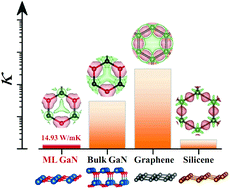Orbitally driven low thermal conductivity of monolayer gallium nitride (GaN) with planar honeycomb structure: a comparative study
Abstract
Two-dimensional (2D) materials with graphene as a representative have been intensively studied for a long time. Recently, monolayer gallium nitride (ML GaN) with honeycomb structure was successfully fabricated in experiments, generating enormous research interest for its promising applications in nano- and opto-electronics. Considering all these applications are inevitably involved with thermal transport, systematic investigation of the phonon transport properties of 2D GaN is in demand. In this paper, by solving the Boltzmann transport equation (BTE) based on first-principles calculations, we performed a comprehensive study of the phonon transport properties of ML GaN, with detailed comparison to bulk GaN, 2D graphene, silicene and ML BN with similar honeycomb structure. Considering the similar planar structure of ML GaN to graphene, it is quite intriguing to find that the thermal conductivity (κ) of ML GaN (14.93 W mK−1) is more than two orders of magnitude lower than that of graphene and is even lower than that of silicene with a buckled structure. Systematic analysis is performed based on the study of the contribution from phonon branches, comparison among the mode level phonon group velocity and lifetime, the detailed process and channels of phonon–phonon scattering, and phonon anharmonicity with potential energy well. We found that, different from graphene and ML BN, the phonon–phonon scattering selection rule in 2D GaN is slightly broken by the lowered symmetry due to the large difference in the atomic radius and mass between Ga and N atoms. Further deep insight is gained from the electronic structure. Resulting from the special sp orbital hybridization mediated by the Ga-d orbital in ML GaN, the strongly polarized Ga–N bond, localized charge density, and its inhomogeneous distribution induce large phonon anharmonicity and lead to the intrinsic low κ of ML GaN. The orbitally driven low κ of ML GaN unraveled in this work would make 2D GaN prospective for applications in energy conversion such as thermoelectrics. Our study offers fundamental understanding of phonon transport in ML GaN within the framework of BTE and further electronic structure, which will enrich the studies of nanoscale phonon transport in 2D materials and shed light on further studies.



 Please wait while we load your content...
Please wait while we load your content...